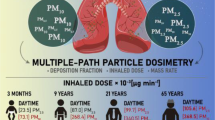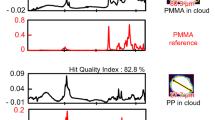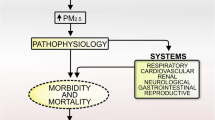Abstract
Many studies have focused their attention on the determination of elements of toxicological and environmental interest in atmospheric particulate matter using analytical techniques requiring chemical treatments. The instrumental nuclear activation analysis technique allows achieving high sensitivity, good precision, and excellent limit of detection without pretreatment, also considering the problems related to the radioisotope characteristics (e.g., half-life time, interfering reactions, spectral interferences). In this paper, elements such as Al, As, Br, Cl, Cu, I, La, Mg, Mn, Na, Sb, Si, Ti, and V are studied in atmospheric PM10 sampled in downtown Rome: The relative radionuclides after activation of the sample are characterized by very short (ranging from 2.24 to 37.2 min) and short (ranging from 2.58 h to 2.70 days) half-lives. Furthermore, As, Br, La, Mn, and Sb were also determined for evaluating the aerosol characteristics. The results, elaborated considering the matrix effects and the interfering reaction contribution to the radioisotope formation (e.g., 28Al generated by both (n,γ) reaction from 27Al and (n,p) reaction from 28Si), show interesting values of As (0.3–6.1 ng m−3), Cu (22–313 ng m−3), Mn (17–125 ng m−3), V (7–63 ng m−3), higher than those determined in an area not influenced by autovehicular traffic, and significant levels of I (1–11 ng m−3) and Ti (25–659 ng m−3) in Rome PM10. The other elements show a pattern similar to the very few data present in the literature. It should be underlined the good correlation (r 2) of Al vs. Mg (0.915) and Al vs. La (0.726), indicating a same sources for these species as well as Br–Sb showing a little lower correlation (0.623). This last hypothesis is confirmed by the study of the enrichment factors: Sb and Br may be attributed to anthropogenic sources; Cu, Cl, and I show a mixed origin (natural and anthropogenic), whereas Al, Si, Ti, Mn, Na, Mg, and As are of crustal origin. For having more information, a statistical approach based on the principal component analysis and the canonical discriminant analysis has been performed: All the samples (except one) are grouped in a cluster, and elements such as As, Br, Cu, I, La, Mn, Sb, Ti, and V are highly correlated, whereas Na and Cl and Mg and Al assemble in two different clusters. Finally, a comparison with other similar studies is reported showing interesting values for Al, As, Mg, Mn, and Ti.


Similar content being viewed by others
References
Alleman LY, Lamaison L, Perdrix E, Robache A, Galloo J-C (2010) PM10 metal concentrations and source identification using positive matrix factorization and wind sectoring in a French industrial zone. Atmos Res 96:612–625
Almeida SM, Freitas MC, Reis M, Pinheiro T, Felix PM, Pio CA (2013) Fifteen years of nuclear techniques application to suspended particulate matter studies. J Radioanal Nucl Chem 297:347–356
Ansari AS, Pandis SN (1999) Prediction of multicomponent inorganic atmospheric aerosol behavior. Atmos Environ 33:745–757
Avino P, Manigrasso M (2008) Ten-year measurements of gaseous pollutants in urban air by an open-path analyzer. Atmos Environ 42:4138–4148
Avino P, Carconi PL, Lepore L, Moauro A (2000) Nutritional and environmental properties of algal products used in healthy diet by INAA and ICP-AES. J Radioanal Nucl Chem 244:247–252
Avino P, Capannesi G, Rosada A (2006) Characterization and distribution of mineral content in fine and coarse airborne particle fractions by neutron activation analysis. Toxicol Environ Chem 88:633–647
Avino P, Capannesi G, Rosada A (2008) Heavy metal determination in atmospheric particulate matter by instrumental neutron activation analysis. Microchem J 88:97–106
Avino P, Capannesi G, Diaco L, Rosada A (2010) Multivariate analysis applied to trace and ultra-trace elements in Italian potable waters determined by INAA. Curr Anal Chem 6:26–36
Avino P, Capannesi G, Rosada A (2011a) Ultra-trace nutritional and toxicological elements in Rome and Florence drinking waters determined by instrumental neutron activation analysis. Microchem J 97:144–153
Avino P, Capannesi G, Manigrasso M, Sabbioni E, Rosada A (2011b) Element assessment in whole blood, serum and urine of three Italian healthy sub-populations by INAA. Microchem J 99:548–555
Avino P, Capannesi G, Renzi L, Rosada A (2013) Instrumental neutron activation analysis and statistical approach for determining baseline values of essential and toxic elements in hairs of high school students. Ecotoxicol Environ Saf 92:206–214
Barksdale J (1968) Titanium. In: Clifford A, Hampel A (eds) The encyclopedia of the chemical elements. Reinhold Book Corporation, New York, pp 732–738, LCCN 68-29938
Bergamaschi L, Rizzio E, Valcuvia MG, Verza G, Profumo A, Gallorini M (2002) Determination of trace elements and evaluation of their enrichment factors in Himalayan lichens. Environ Pollut 120:137–144
Bruno F, Capannesi G, Gratani L, Manes F (1980) Characterization of mineral content in Quercus ilex leaves by photon and neutron activation analysis (Castelporziano, Rome). G Bot Ital 114:175–186
Buonanno G, Stabile L, Avino P, Vanoli R (2010) Dimensional and chemical characterization of particles at a downwind receptor site of a waste-to-energy plant. Waste Manag 30:1325–1333
Buonanno G, Stabile L, Avino P, Belluso E (2011) Chemical, dimensional and morphological ultrafine particle characterization from a waste-to-energy plant. Waste Manag 31:2253–2262
Campanella L, Crescentini G, Avino P, Moauro A (1998) Determination of macrominerals and trace elements in the alga Spirulina platensis. Analusis 26:210–214
Canepari S, Pietrodangelo A, Perrino C, Astolfi ML, Marzo ML (2009) Enhancement of source traceability of atmospheric PM by elemental chemical fractionation. Atmos Environ 43:4754–4765
Capannesi G, Mastinu G (1978) Trace elements in air particulates from 1965 to 1978. CNEN Report RT/AMB (79)10:1–27.
Capannesi G, Diaco L, Rosada A, Avino P (2008) Investigation of trace and ultra-trace elements of nutritional and toxicological significance in Italian potable waters by INAA. J Radioanal Nucl Chem 278:353–357
Capannesi G, Rosada A, Avino P (2009) Elemental characterization of impurities at trace and ultra-trace levels in metallurgical lead samples by INAA. Microchem J 93:188–194
Capannesi G, Rosada A, Manigrasso M, Avino P (2012) Rare earth elements, thorium and uranium in ores of the North-Latium (Italy). J Radioanal Nucl Chem 291:163–168
Carvalho AOM, Freitas MC (2011) Airborne chemical elements: implications on human health and accumulation in lichens. Int J Environ Health 5:134–147
Cecinato A (1999) Atmospheric PAH in Italy: experience and concentration levels. Fresenius Environ Bull 8:586–594
Chen Z, Huang C-Y, Zhao M, Yan W, Chien C-W, Chen M, Yang H, Machiyama H, Lin S (2011) Characteristics and possible origin of native aluminum in cold seep sediments from the northeastern South China Sea. J Asian Earth Sci 40:363–370
Cheung K, Daher N, Kam W, Shafer MM, Ning Z, Schauer JJ, Sioutas C (2011) Spatial and temporal variation of chemical composition and mass closure of ambient coarse particulate matter (PM10–2.5) in the Los Angeles area. Atmos Environ 45:2651–2662
Cocheo V (2000) Agenti inquinanti e sorgenti dell'inquinamento atmosferico urbano. Ann Ist Sup San 36:267–279
Currie LA (1968) Limits for qualitative detection and quantitative determination. Application to radiochemistry. Anal Chem 40:586–593
Della Ventura G, Bellatreccia F, Caprilli E, Rossi P, Fiori S (1999) Minerali di vanadio nei proietti sienitici del Lazio: la vanadinite di Monte Cavalluccio, Campagnano (Roma). Rend Acc Naz Lincei 10:81–87
Dongarrà G, Manno E, Varrica D, Lombardo M, Vultaggio M (2010) Study on ambient concentrations of PM10, p M10–2.5, PM2.5 and gaseous pollutants. Trace elements and chemical speciation of atmospheric particulates. Atmos Environ 44:5244–5257
Dulka JJ, Risby TH (1976) Ultratrace metals in some environmental and biological systems. Anal Chem 48:640A–653A
Emsley J (2001) Titanium. Nature's building blocks: an A–Z guide to the elements. Oxford University Press, Oxford. ISBN 0-19-850340-7
Erdtmann G, Soyka W (1988) The gamma rays of the radionuclides. Wiley-VCH, New York. ISBN 3527258167
European Standard 123241 (1998) Air quality—determination of the PM10 fraction of suspended particulate matter—reference method and field test procedure to demonstrate reference equivalence of measurements methods. European Commision, Strasbourg
Fanizza C, Capannesi G, Rosada A, Manigrasso M, Avino P (2008) Rare earth elements in atmospheric PM10: analytical and toxicological implications. Toxicol Lett 180S:S178
Felig P, Frohman LA (2001) Endemic goiter, Endocrinology & metabolism. McGraw-Hill Professional, New York. ISBN 9780070220010
Gallorini M, Muntau H (1995) Materiali di riferimento e analisi di elementi in traccia. Ann Ist Sup San 31:255–263
Gao Y, Sun M, Wu X, Liu Y, Guo Y, Wu J (2010) Concentration characteristics of bromine and iodine in aerosols in Shanghai, China. Atmos Environ 44:4298–4302
Gaudry A, Moskura M, Mariet C, Ayrault S, Denayer F, Bernard N (2008) Inorganic pollution in PM10 particles collected over three French sites under various influences: rural conditions, traffic and industry. Water Air Soil Pollut 193:91–106
Gobbi GP, Angelini F, Barnaba F, Costabile F, Baldasano JM, Basart S, Sozzi R, Bolignano A (2013) Changes in particulate matter physical properties during Saharan advections over Rome (Italy): a four-year study, 2001–2004. Atmos Chem Phys 13:7395–7404
Greenwood NN, Earnshaw A (1997) Chemistry of the elements, 2nd edn. Butterworth-Heinemann, Oxford. ISBN 0080379419
Halek F, Keyanpour-Rad M, Darbani RM, Kavousirahim A (2010) Concentrations and source assessment of some atmospheric trace elements in Northwestern region of Tehran, Iran. Bull Environ Contam Toxicol 84:185–190
Harrison RM, Sturges WT (1984) Physico-chemical speciation and transformation reactions of particulate atmospheric nitrogen and sulphur compounds. Atmos Environ 18:1829–1833
Hetherington LE, Brown TJ, Benham AJ, Lusty PAJ, Idoine NE (2007) World mineral production: 2001–2005. British Geological Survey. ISBN 978-0-85272-592-4 (available at www.bgs.ac.uk/downloads/start.cfm?id=1417)
Koski TA, Stuart LS, Ortenzio LF (1966) Comparison of chlorine, bromine, iodine as disinfectants for swimming pool water. Appl Microbiol 14:276–279
Krebs RE (2006) The history and use of our earth's chemical elements: a reference guide, 2nd edn. Greenwood, Westport. ISBN 0313334382
Kroll A, Gietl JK, Wiesmüller GA, Günsel A, Wohlleben W, Schnekenburger J, Klemm O (2013) In vitro toxicology of ambient particulate matter: correlation of cellular effects with particle size and components. Environ Toxicol 28:76–86
Laborda F, Baxter MJ, Crews HM, Dennis J (1994) Reduction of polyatomic interferences in inductively coupled plasma mass spectrometry by selection of instrumental parameters and using an argon–nitrogen plasma: effect on multi-element analyses. J Anal At Spectrom 9:727–736
Lahmann E, Munari S, Amicarelli V, Abbaticchio P (1986) Heavy metals: identification of air quality and environmental problems in the European Community. Luxembourg, Commission of the European Communities, vols 1 and 2 (Report No. EUR 10678 EN/I and EUR 10678 EN/II)
Leclerc JC, Cornu A (1989) Neutron activation analysis table. Heyden, London. ISBN 0855010851
Lide DR (2005) CRC handbook of chemistry and physics, 86th edn. CRC, Boca Raton. ISBN 0-8493-0486-5
Locardi E, Mittempergher M (1967) Relationship between some trace elements and magmatic processes. Int J Earth Sci 57:313–334
Lyle JP, Granger DA, Sanders RE (2005) Aluminum alloys, Ullmann's encyclopedia of industrial chemistry. Wiley-VCH, Weinheim. doi:10.1002/14356007.a01 481
Manigrasso M, Avino P (2009) Ten-year measurements of gaseous pollutants in urban air by an open-path analyzer. Atmos Environ 42:4138–4148
Manigrasso M, Abballe F, Jack RF, Avino P (2010) Time-resolved measurement of the ionic fraction of atmospheric fine particulate matter. J Chromatogr Sci 48:549–552
Masiol M, Squizzato S, Ceccato D, Rampazzo G, Pavoni B (2012) A chemometric approach to determine local and regional sources of PM10 and its geochemical composition in a coastal area. Atmos Environ 54:127–133
Mason B, Moore CM (1982) Principles of geochemistry, 4th edn. Wiley, New York, p 344
Michelozzi P, Forasteriere F, Fusco D, Perucci CA, Ostro B, Ancona C, Pallotti G (1998) Air pollution and daily mortality in Rome, Italy. Occup Environ Med 55:605–610
Misaelides P, Samara C, Noli F, Kouimtzis T, Anou I (1993) Toxic element concentrations in airborne particulate matter in the area of Thessaloniki, Greece. Sci Total Environ 130:139–146
Moiseyev VN (2006) Titanium alloys: Russian aircraft and aerospace applications. Taylor and Francis, London, p 196. ISBN 9780849332739
Monod A, Sive BC, Avino P, Chen T, Blake DR, Rowland FS (2001) Monoaromatic compounds in ambient air of various cities: a focus on correlations between the xylenes and ethylbenzene. Atmos Environ 35:135–149
Moreno T, Querol X, Alastuey A, Reche C, Cusack M, Amato F, Pandolfi M, Pey J, Richard A, Prévôt ASH, Furger M, Gibbons W (2011) Variations in time and space of trace metal aerosol concentrations in urban areas and their surroundings. Atmos Chem Phys 11:9415–9430
Müller K (1999) A 3 year study of the aerosol in northwest Saxony (Germany). Atmos Environ 33:1679–1685
Pakkanen TA (1996) Study of coarse particles nitrate aerosol. Atmos Environ 30:2475–2482
Park SH, Song CB, Kim MC, Kwon SB, Lee KW (2004) Study on size distribution of total aerosol and water soluble ions during an Asian dust storm event at Jeju Island, Korea. Environ Monit Assess 93:157–183
Pey J, Querol X, Alastuey A (2010) Discriminating the regional and urban contributions in the North-Western Mediterranean: PM levels and composition. Atmos Environ 44:1587–1596
Platzner I, Sala JV, Mousty F, Trincherini PR, Polettini AL (1994) Signal enhancement and reduction of interferences in inductively coupled plasma mass spectrometry with an argon–trifluoromethane mixed aerosol carrier gas. J Anal At Spectrom 9:719–726
Reed NM, Cairns RO, Hutton RC (1994) Characterization of polyatomic ion interferences in inductively coupled plasma mass spectrometry using a high resolution mass spectrometer. J Anal At Spectrom 9:88–896
Rudnick RL, Gao S (2003) Composition of the continental crust. In: Holland HD, Turekian KK (eds) Treatise on geochemistry, vol 3. Elsevier, Amsterdam, pp 1–64. ISBN 0-08-044338-9
Seccaroni C, Volante N, Rosada A, Ambrosone L, Bufalo G, Avino P (2008) Identification of provenance of obsidian samples analyzing elemental composition by INAA. J Radioanal Nucl Chem 278:277–282
Seinfeld JH, Pandis SN (2006) Atmospheric chemistry and physics—from air pollution to climate change, 2nd edn. Wiley, New York. ISBN 0471720186
Smodiš B, Bleise A (2007) IAEA quality control study on determining trace elements in biological matrices for air pollution research. J Radioanal Nucl Chem 271:269–274
Tan SH, Horlick G (1986) Background spectral features in inductively coupled plasma/mass spectrometry. Appl Spectrosc 40:445–460
Tanagra (2013) http://chirouble.univ-lyon2.fr/~ricco/tanagra/en/tanagra.html. Accessed on 28 June 2013
Terzi E, Argyropoulos G, Bougatioti A, Mihalopoulos N, Nikolaou K, Samara C (2010) Chemical composition and mass closure of ambient PM10 at urban sites. Atmos Environ 44:2231–2239
Theodosi C, Im U, Bougiatioti A, Zarmpas P, Yenigun O, Mihalopoulos N (2010) Aerosol chemical composition over Istanbul. Sci Total Environ 408:2482–2491
Titanium (2006) The Columbia encyclopedia, 6th edn. Columbia University Press, New York. ISBN 0-7876-5015-3
Verburg TG, Sarmento SM, Wolterbeek HT (2010) Statistical approaches in environmental epidemiology. In: Lahiri S (ed) Advanced trace analysis. Alpha Science International, Oxford, pp 1–73. ISBN 1842655914
von Schneidemesser E, Stone EA, Quraishi TA, Shafer MM, Schauer JJ (2010) Toxic metals in the atmosphere in Lahore, Pakistan. Sci Total Environ 408:1640–1648
Wang C, Wang J, Yang Z, Mao C, Ji J (2013) Characteristics of lead geochemistry and the mobility of Pb isotopes in the system of pedogenic rock-pedosphere-irrigated riverwater-cereal-atmosphere from the Yangtze River delta region, China. Chemosphere 93:1927–1935. doi:10.1016/j.chemosphere.2013.06.073
Wiberg E, Wiberg N, Holleman AF (2001) Inorganic chemistry. Academic, New York. ISBN: 0123526515.
World Health Organization (2000) Air quality guidelines for Europe, 2nd edn. WHO Regional Publications, European Series, No. 91. ISBN: 92-890-1358-3
Acknowledgments
This research was performed under the grant INAIL/P20L01.
Author information
Authors and Affiliations
Corresponding author
Additional information
Responsible editor: Gerhard Lammel
Electronic supplementary material
Below is the link to the electronic supplementary material.
Figure 1
Efficiency calibration curve (JPEG 19 kb)
Figure 2
Typical spectrum of first series of measurements of short-lived radionuclides determined in PM10 sample. Peak identification: 1 51Ti; 2 128I; 3 76As; 4 80Br; 5 80Br; 6 82Br; 7 56Mn; 8 27Mg; 9 66Cu; 10 29Al(Si); 11 24Na; 12 52V; 13 38Cl; 14 28Al; 15 56Mn; asterisk e+ + e− (annihilation) (JPEG 32 kb)
Rights and permissions
About this article
Cite this article
Avino, P., Capannesi, G. & Rosada, A. Source identification of inorganic airborne particle fraction (PM10) at ultratrace levels by means of INAA short irradiation. Environ Sci Pollut Res 21, 4527–4538 (2014). https://doi.org/10.1007/s11356-013-2418-y
Received:
Accepted:
Published:
Issue Date:
DOI: https://doi.org/10.1007/s11356-013-2418-y




